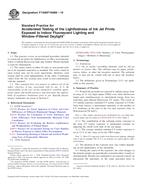We need your consent to use the individual data so that you can see information about your interests, among other things. Click "OK" to give your consent.
ASTM F1946/F1946M-10
Standard Practice for Determining the Lightfastness of Ink Jet Prints Exposed to Indoor Fluorescent Lighting and Window-Filtered Daylight (Withdrawn 2016)
Automatically translated name:
Standard Practice for Determining the Lightfastness of Ink Jet Prints Exposed to Indoor Fluorescent Lighting and Window-Filtered Daylight
STANDARD published on 1.10.2010
The information about the standard:
Designation standards: ASTM F1946/F1946M-10
Note: WITHDRAWN
Publication date standards: 1.10.2010
SKU: NS-52182
The number of pages: 3
Approximate weight : 9 g (0.02 lbs)
Country: American technical standard
Category: Technical standards ASTM
The category - similar standards:
Annotation of standard text ASTM F1946/F1946M-10 :
Keywords:
accelerated testing , color change , image stability , ink jet , ink jet prints , lightfastness , UV exposure , window-filtered daylight, Accelerated aging/testing--copy materials, Daylight, Fluorescent lamps/lighting, Lightfastness, Overhead fluorescent lighting, Window-filtered daylight, ICS Number Code 87.080 (Inks. Printing inks)
Additional information
| Significance and Use | ||||||||||||
|
Lightfastness of printed ink jet media for specified periods of time is pertinent to the end use of these materials. Since the ability of an ink jet print to withstand color changes is a function of the spectral power distribution of the light source to which it is exposed, it is important that the effect of accelerated testing be assessed under the conditions appropriate to the end use application. While ink jet prints may be handled and displayed under a variety of conditions, this practice is intended to produce the color changes that may occur in ink jet prints upon exposure to irradiation from office lighting where overhead fluorescent light and window-filtered daylight is used for illumination by simulating these conditions. The accelerated procedure covered in this practice is intended to provide a means for the rapid evaluation of the effect of light under laboratory conditions. Test results are useful for specification acceptance between producer and user, for quality control, and for research and product development. Color changes may not be a linear function of duration of exposure. The preferred method of determining the effect of light is to expose the prints for a number of intervals and to assess the exposure time required to obtain a specific color change. |
||||||||||||
| 1. Scope | ||||||||||||
|
1.1 This practice covers an accelerated procedure intended to screen ink jet prints for lightfastness in office environments where overhead fluorescent light and window-filtered daylight is used for illumination. 1.2 The values stated in either SI units or inch-pound units are to be regarded separately as standard. The values stated in each system may not be exact equivalents; therefore, each system shall be used independently of the other. Combining values from the two systems may result in non-conformance with the standard. 1.3 This standard does not purport to address all of the safety concerns, if any, associated with its use. It is the responsibility of the user of this standard to establish appropriate safety and health practices and determine the applicability of regulatory limitations prior to use. Specific precautionary statements are given in Section 8. |
||||||||||||
| 2. Referenced Documents | ||||||||||||
|
We recommend:
Technical standards updating
Do you want to make sure you use only the valid technical standards?
We can offer you a solution which will provide you a monthly overview concerning the updating of standards which you use.
Would you like to know more? Look at this page.




 Cookies
Cookies
